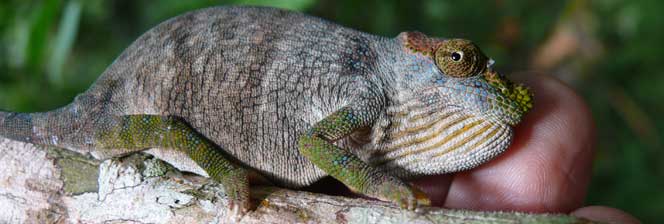Changing the world for 50 years
Protecting the Tanzanian rainforest
Posted on Wednesday 30 January 2013
Discoveries of new species and collaborations with a local zoo and Tanzanian communities have led to renewed efforts to conserve important rainforest in Tanzania.

A magomera chameleon, discovered in Tanzania by Dr Andy Marshall
When Dr Andy Marshall, an academic in York's Environment Department, discovered a new species of tree in a Tanzanian forest recently, he was presented with the enjoyable challenge of what to name it. He had been here before: in 2009, while out surveying monkeys, he had disturbed a tree snake eating a previously unidentified type of chameleon. He had named it the Magombera Chameleon – to draw attention to the plight of the endangered rainforest at the foot of the Udzwunga Mountains that he wants the Tanzanian government to make a protected area.
Preserving the rainforest
The goal everywhere is to stop losing so much forest.
Dr Andy Marshall
"After articles appeared in the international press I got a 'phone call at Flamingo Land from the Head of the Commission for Science and Technology in Tanzania, who I had never met before, to say, "Okay, I want to help you in your fight to preserve this forest.'" recalls Andy, who divides his time between this zoo on the edge of the North York Moors, York’s Environment Department and fieldwork in Africa. So how can he ensure the naming of the tree has the same impact? "Well, we're in talks with an organisation that might potentially fund some of our work in return for the name," he says.
Sustainable conservation
Andy, meanwhile, has created a direct connection between York's Environment Department, Flamingo Land and the villagers of the Magombera Forest. A trust fund set up by Flamingo Land guarantees the annual salaries of seven Tanzanians employed to conserve the forest. Those bonds will only strengthen: the Environment Department is currently researching how they can use the example of their work in the Magombera forest to improve how Rain Forest conservation is taught to school pupils in Yorkshire. The Circle Institute (Centre for the Integration of Research, Conservation and Learning), which is co-funded by the University and Flamingo Land, but based at the North Yorkshire theme park, has since 2010 dedicated itself to conservation awareness and education, applying its findings locally and in their Udzungwa Forest project. And it's not one-way traffic: Marshall, who is a passionate proponent of the conservation work being done in modern zoos, is drawing on his experience in Africa to write a biodiversity action plan for the wildlife native to Flamingo Land. "The solutions are not so different," he says. "The goal everywhere is to stop losing so much forest."
From an interview with Patti Nicol for Grapevine Magazine
Related links
- The University's Environment Department
Discover our leading centre for teaching and research on sustainable solutions to environmental issues - Dr Andy Marshall's profile page
Learn more about the researcher featured in this story - Flamingo Land's Udzungwa Forest Project
Find out more about the conservation, research and education work ongoing in Tanzania
50 years of gold standard achievement
Cutting edge research, pioneering medical breakthroughs and thought-provoking academic insight have formed our core purpose since 1963.
This series, which will run throughout 2013, will demonstrate how our research, teaching and the application of both have brought tangible benefits to society and changed our understanding of the world we live in.
Previous story
Next story
More to come
We'll be adding to this series all throughout 2013.
To keep up to date with our latest news, you can: